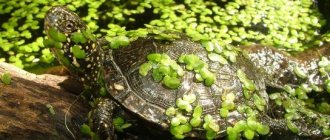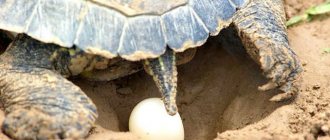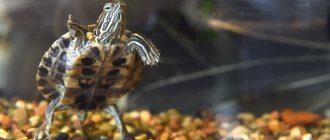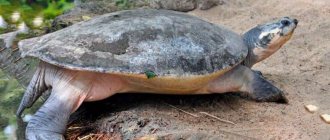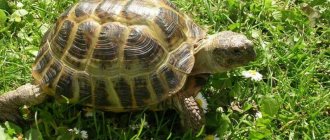It happens that you get a pet, look after it, take care of it, and at some point it gets sick or simply loses its appetite. This can easily happen to a red-eared turtle, which can be very finicky in its care. Of course, she won’t say why she doesn’t want to eat, but it’s quite possible to watch her and try to figure out what’s wrong yourself. And you should not hesitate with this in order to take timely measures and avoid complications.
Causes of loss of appetite
There are many things you should pay attention to to help your turtle feel the joy of life again. Some of the possible reasons that could deprive the mammal of calm:
- Getting used to a new environment;
- Adaptation in captivity;
- Disease;
- Stress;
- Intestinal problems;
- Extreme temperatures (cold or hot);
- Puberty;
- Poor nutrition.
The main reasons for the reluctance to eat are considered to be stress from a change in habitat and hypothermia of the animal. From the transportation process itself, the reptile’s nervous system can be severely damaged and it will take more than one day to recover.
Features of turtle wintering
The first of the reasons we have listed—the dependence of a turtle’s diet on the season—is directly related to its behavior in the wild. Starting in October, turtles begin to eat worse and less often. This is how they react not only to the decreasing day, but also prepare themselves for hibernation. Naturally, they demonstrate the same behavior in captivity, so if the turtle’s refusal to eat coincides with the “Indian summer” period (and there are no signs of illness), most likely your reptile is preparing for sleep. However, herpetologists do not advise encouraging the turtle’s desire for such a long sleep, explaining this by the fact that at home there is only a slight decrease in its activity, during which there is no need for hibernation. Therefore, if a turtle, obeying the dictates of nature, attempts to fall asleep for a long time, you need to increase the temperature of its environment and increase the brightness of the lighting in its aquarium. With such an increase, the turtle will begin to feed on its own in January, when the length of daylight hours increases.
If you missed the moment and the turtle still fell asleep, then you need to move it to a box, put it in a damp and cool place and follow the calendar: by mid-March the reptile should wake up. If this does not happen, be sure to wake it up, otherwise the turtle will die from prolonged dehydration and starvation. You can wake up the turtle by gradually moving its temporary home to a brighter and warmer place.
A turtle that wakes up in the spring, especially one that has spent the winter without moisture and at a relatively high temperature, is characterized by natural anorexia (exhaustion of the body). However, a healthy reptile, no matter how exhausted it may be, will begin to feed approximately a day or two after waking up and turning on the heating. If in the spring it has not started feeding within five weeks and is also in a state of lethargy, you must definitely show it to the veterinarian: long wintering of turtles is associated not only with starvation, but also with dehydration, the consequences of which can be gout and liver or kidney failure.
Solution
After carefully observing your pet and, unfortunately, not finding out the true reasons for his starvation, the best solution would be to make every effort to create comfortable conditions for your turtle. The following instructions will help:
- To begin with, take care of a fairly large turtle “house” - an aquaterrarium, the volume of which should be about 200 liters. The container should only be filled halfway.
- Usual conditions. Care must be taken to ensure that the turtle feels at home, where it spends most of its time not in the water, but on land. To do this, you need to equip a small island in the middle made of high-quality plexiglass with recesses that will provide the turtle with convenience and comfort when diving onto it. A bedding made of moss, sand, algae or other material that will not make the water cloudy is also suitable. It is important to take into account that the pebbles should not be small, otherwise the lover of absorbing everything in her path may become very ill.
- Water purity. The fluid must be changed at least once a week, and preferably when it becomes dirty. The water will be of high quality and suitable for your red-eared beauty if you first settle it and pass it through a filter.
- Amount of water. Only 30 cm of liquid is enough for the reptile to feel at home and be able to easily get out onto land.
- Suitable climate. To do this, you need to maintain the water temperature in the aquarium starting from +26⁰С and make sure that it does not rise above + 35⁰С. If the house is cold, heaters will help. The air temperature will also be suitable, and this is a couple of degrees more than that of water, if you use ultraviolet irradiators or incandescent lamps. These devices will provide air heating and will also help the patient fight rickets.
What does a pet need for a long life?
When properly cared for, these reptiles can live up to fifty years, so keeping them is expensive. You can make an aquarium yourself or buy a suitable, optimal volume of approximately 100–120 liters. One third of the dwelling's area is land, connected to the water part by a rough ladder. There should be enough water in the aquaterrarium for the reptile to move freely: usually the turtle does not move or swim if there is insufficient space.
The water temperature should be higher than room temperature, so additionally purchase a thermostat based on the capacity of the aquarium. To heat the surface air space, I use 40–60 W incandescent lamps, which are usually turned on during the day. For the formation of vitamin D in the pet’s body and the absorption of calcium, it is necessary to install ultraviolet lamps with UVB 10%.
The water used is regular tap water. Turtles heavily pollute the aquarium; for regular cleaning, you need a filter whose volume is two or three times larger than the actual one.
Diet of the red-eared slider
To avoid loss of appetite, you should not allow your pet to eat low-quality food. This will have a detrimental effect on her health and lead to serious illness. Several points relate to this:
- The presence of animal products in the diet (seafood, fish, liver, bird offal);
- Plant foods (apples, cabbage, spinach, carrots, lettuce, dandelion greens);
- Restriction in feeding with special food for turtles;
- Don't let her crawl around on the floor, where she might, as usual, ingest something and become infected with salmonella;
- Avoid monotony. Food should be very varied and nutritious.
If you have done everything possible to create suitable conditions for your pet, and, despite everything, she looks very weak, exhausted, lost weight, does not leave the water and sleeps a lot, then you need to urgently treat her. And not on your own, for example, using the Internet, but by contacting a turtle specialist - a herpetologist, who can professionally find out the reason behind the lack of appetite. Before that, try to pamper your turtle: feed it seaweed, because this is its most favorite treat! And who knows, he might suddenly be tempted and start eating?
Diseases
If, in addition to refusing food, external changes in the skin, eyes and shell are observed, lethargy, an imbalance in the reptile’s body position in the water, or a reluctance to swim, it is necessary to urgently contact a specialist. A sick reptile that does not eat for more than a month may die. Refusal to feed is observed in the following common diseases of ornamental turtles:
- Rickets is a disease caused by a lack of vitamin D and calcium. Sometimes a metabolic disease occurs due to impaired absorption of calcium by the body. The cause of rickets is improper feeding, lack of a source of ultraviolet radiation, kidney and stomach diseases. A sick pet experiences softening and deformation of the shell, swelling and fractures of the legs, bleeding, prolapse of the cloaca and failure of the hind limbs.
- Hypovitaminosis A - a lack of retinol manifests itself in a slowdown in the growth rate of young animals. When the disease occurs, the eyes become swollen and the oral mucosa becomes inflamed.
- Pneumonia is a deadly disease for turtles. Inflammation of the lungs in reptiles occurs as a result of hypothermia, being on a cold floor, complications of rhinitis, or being kept in dirty or cold water. With pneumonia, the turtle refuses to feed, becomes lethargic and inactive, often stretches its neck and opens its mouth. A characteristic symptom of pneumonia in a reptile is falling on its side when swimming. The breathing of a sick animal becomes heavy and noisy, sometimes wheezing, clicking and squeaking can be clearly heard.
- Eye diseases - ophthalmological pathologies in aquatic turtles develop due to a lack of vitamin A, keeping the reptile in dirty water, burns from an ultraviolet lamp and injuries. The reptile's eyes become very swollen, close and stick together, the animal stops moving and feeding on its own.
- Intestinal pathologies - diseases of the gastrointestinal tract are the result of improper feeding, keeping the reptile in dirty water and the animal being infected with helminths or intestinal infection. A sick turtle tries to sit on the shore, refuses food and becomes lethargic; when swimming, the pet cannot dive, the back part lifts up. The main symptoms of pathologies of the digestive system in reptiles are constipation or diarrhea with an unpleasant odor.
- Injuries - various microtraumas, scratches, burns, broken limbs and cracks in the shell, the animal most often receives as a result of careless handling of the owners or attacks by other pets. Sometimes the cause of injury is bloody fights between males and competitors during mating games, the female’s refusal to accept a persistent gentleman, and aggression towards introducing new relatives.
- Dermatomycoses are fungal diseases of the skin and shell that develop in reptiles through contact with an infected animal, exposure to dirty water, or complications from bacterial infections.
With dermatomycosis, red-eared turtles refuse food, lose weight and become lethargic. White or red nodules, ulcers, and white plaque appear on the skin and shell. The scutes of the shell begin to peel off and become deformed; if left untreated, the animal may die.
What to do if a red-eared turtle refuses food due to illness?
The causes of diseases in pet turtles are violations of the conditions of keeping and feeding of aquatic reptiles. If an exotic animal has stopped crawling and swimming, constantly lies on the bottom, floats up or falls on its side, the reptile’s eyes are swollen, there is deformation or softening of the shell, fractures, a rash on the skin, bleeding, clicks and wheezing are heard when breathing, you should not waste time or do it yourself Treat your pet with medications from your home medicine cabinet. Prescribing specific drugs and calculating the dosage in each specific case should be done by a veterinarian; it is best to find an experienced herpetologist. A specialist will understand the reasons for refusing food and tell you how to feed a sick reptile.
Improper care
Reptiles are cold-blooded animals whose metabolism slows down when environmental conditions change, as a result of which the animals move little and do not eat. Comfortable temperature for red-eared turtles is +26-28C in water and +28-32C on land with a day length of 12-14 hours. When keeping a pet in other conditions, the turtle becomes inactive and eats poorly; in such conditions, the animal becomes vulnerable to the action of pathogenic microorganisms and fungi.
What to do if the turtle stops eating due to violation of the conditions of detention?
To prevent the reptile from getting sick, it is necessary to keep the red-eared turtle in clean, settled water at the optimal temperature; the aquarium must have heating islands and a cleaning system. A prerequisite for the normal functioning of reptiles is the installation of a fluorescent and ultraviolet lamp, as well as balanced feeding with a high content of protein products.
WHAT TO DO?
The reason why the red-eared turtle has lost its appetite can be eliminated either independently or with the help of a veterinarian. It all depends on how serious the situation is.
Adsense clicker for making money on Google AdSense from 500 to 1000 dollars per month
If you feed frequently, you should reduce the amount and start giving as much food as the turtle can eat at one time. Leftover food is removed immediately, otherwise it may spoil, which will lead to illness if the turtle decides to eat it. Most often you can give vegetables and herbs. Adult turtles are mainly herbivores, so they are fed protein foods periodically.
When preparing a turtle for hibernation, you need to bring it out of this state. Reptiles of this species hibernate under certain conditions that are almost impossible to create at home. A turtle may fall asleep and never wake up, especially if for some reason it is weakened and exhausted.
In the aquaterrarium, you need to increase the water temperature to 28 degrees, make the lighting brighter and longer. Daylight hours should be increased by two or three hours.
When keeping male and female red-eared turtles in the same aquarium, you can observe their mating games. Upon completion of mating, the animals will begin to eat, so you should just wait, since nothing will be done in this case.
If you have a water turtle at home, then you should know the basic rules for caring for the reptile.
Recommendations for choosing the optimal terrarium for the house red-eared turtle - https://tvoipitomec.com/cherepahi/terrariumyi-dlya-krasnouhih-cherepah.html
It should be noted that for female turtles of this species, sexual maturity occurs at the age of four years. Males are ready to reproduce at the age of five. Therefore, if the reptiles are younger, the reason for refusing to eat lies elsewhere.
Video: getting to know your pet
For a sick turtle, it is advisable to determine the symptoms. When there are no visible causes and the development of the disease has not been identified, it is advisable to consult a veterinarian. During the examination, possible causes of the disease will be identified, the correct treatment will be prescribed and the necessary manipulations will be carried out. In addition, the veterinary clinic will give the necessary recommendations for further care of the turtle. Very often, experts recommend taking special vitamin complexes for freshwater reptiles.
It is strictly forbidden to self-treat your pet. In most cases it will be incorrect and may make the turtle's condition even worse.
Video: Why doesn't he eat?
Floats up with mouth open
Most often, a red-eared slider can get pneumonia. If she is lethargic, refuses to eat, and floats up with her mouth open, then most likely she has pneumonia.
This may happen in the following cases:
- if the reptile was left without heating for a long time;
- the water in her aquaterrarium was too cold, and the animal spent a long time in it;
- the turtle ran away from its place of detention and, before the owner noticed it, managed to be in a draft.
Determining which lung is inflamed is very simple. You just need to notice which side the turtle falls on when swimming. The affected side will always be more submerged in the water. At the same time, the reptile opens its mouth, since it is difficult for it to breathe and cannot be under water.
If such symptoms appear, you should seek help from a veterinarian. If the diagnosis is confirmed, then only the owner’s compliance with all instructions and recommendations can save the reptile.
It is always easier to prevent a disease than to treat an animal later. In order for the red-eared turtle to be active, healthy and not cause any problems to the owner, it is necessary to comply with the conditions of detention, properly feed and care for the animal.

